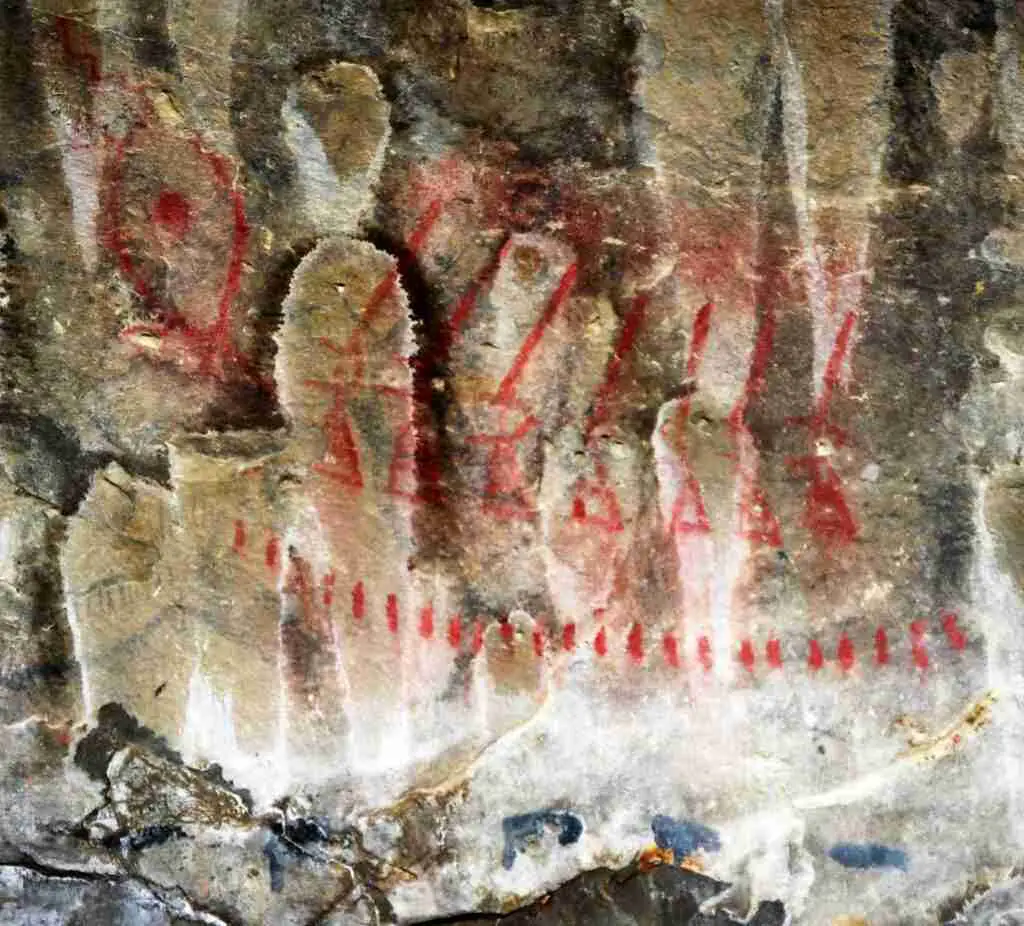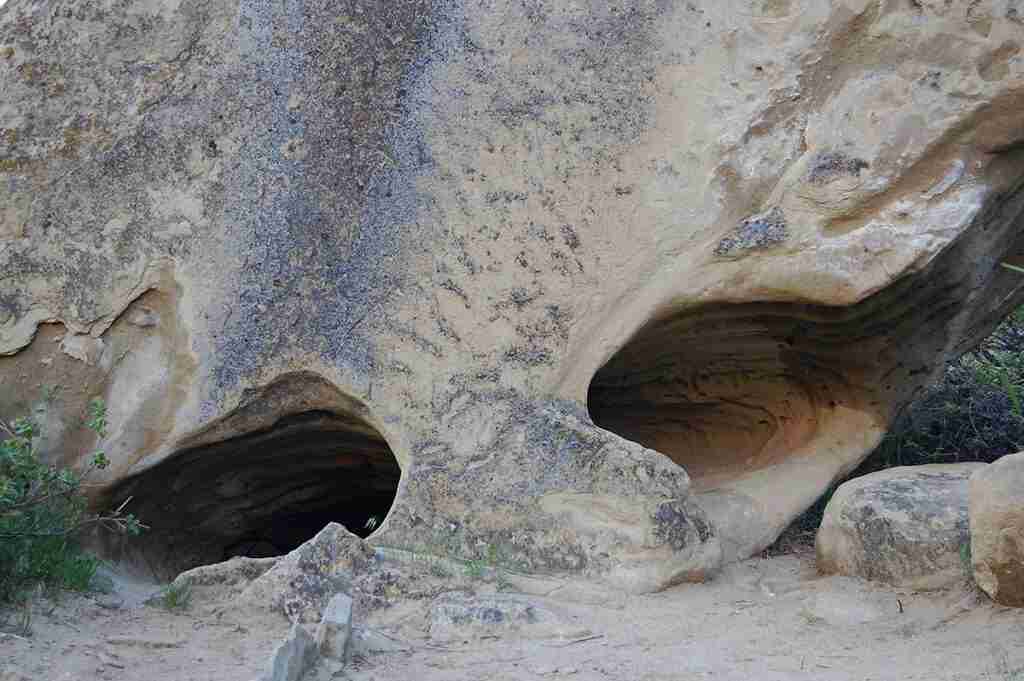Pictograph Cave State Park, 15 minutes south of Billings, Montana, has some unexpected drawings. Seven red rifles decorate a shield on the back of Pictograph Cave. The rifles are obviously the newest art, but a black 2,000-year-old turtle is the oldest drawing.

The startling red ochre rifles alone make the park worth visiting. Then add its geology and scenery for an enjoyable outing.
Roxie’s reliable report: What’s the difference between pictographs and petroglyphs? Both are rock art types, but people paint pictographs. Peter Piper pecked (or carved) his petroglyphs.

Roxie’s reliable recommendation: Explore a tipi and eat a picnic lunch between the visitors center and the trail to the caves.
On the way to the 23-acre state park, a bluff rises on one side of Coburn Road. A coulee stands on the other. Then the cliff abruptly recedes from the road, leaving room for a parking lot and visitors center. Rocks overhang the bluff’s wall, forming three caves.
The park’s name indicates that early humans left two millennia’s worth of artifacts and cave drawings. The caves were in a prime location next to Bitter Creek, a Yellowstone River tributary. The safety of a high, protected place attracted visitors.
Related: Pictograph Cave is one of our favorite places in Southeast Montana.

Before you run up the quarter-mile slope from the visitors center to the cave, stop and appreciate the scene. Pictograph Cave is on the right. At 160 feet wide and 45 feet deep, it’s the most extensive cave. Ghost Cave is on the left, but no trail goes to Middle Cave. Two black streaks on the rock point to that cave.

Roxie’s reliable report: The canyon’s ironic name is Empty Gulch. Allow at least an hour. Leashed dogs are welcome.
Experience Pictograph Caves’ geology
Geology formed the three caves before the people arrived. Rocky Mountain rivers deposited sediment into the Western Interior Sea during the Cretaceous Period. The sea connected the Arctic Ocean to the Gulf of Mexico. It reached from Montana’s Rocky Mountain Front nearly to Lake Superior in Minnesota.
Since sand is the lightest sediment, it dropped near the shore. The heavier silts and clays fell out later. Marine life died and settled on the sea floor. Those layers combined with river sand to become Eagle sandstone.
The sandstone formed rimrocks 250 feet high on the seashore in the Billings area. Then groundwater leached out the sandstone’s binders to form caves. Wind later added the cave’s final touches.
Related: To see some of the best Western Interior Sea fossils, visit the Sternberg Museum in Hays, Kansas.
Article continues below the form.
Expand Pictograph Cave’s human history
In May 1823, Robert Jones and Michael Immel led 30 Missouri Fur Co. trappers through the Yellowstone Valley. They never made it out. In a narrow passage, Blackfeet warriors ambushed them and killed both leaders and five other trappers. Four others fell wounded.
The company lost nearly $15,000 worth of furs, and it disbanded a year later.
The red ochre rifles may tell the story from the Blackfeet perspective.
Roxie’s reliable report: The Blackfeet later sold the furs to the Hudson’s Bay Company in Edmonton, Alberta, Canada. Since the Blackfeet and the Arikara had attacked American fur traders about the same time, the Americans believed the British were inciting violence. The British denied this.
For millennia before the red rifles, indigenous people camped in the caves.

Roxie’s reliable report: Look for the empty eyes staring from the rock between Pictograph and Ghost Caves.
Reading Apsáalooke rock art
In Pictograph Cave, interpretive signage explains the art. Unfortunately, time and vandals have dimmed and even erased some images.
Roxie’s reliable recommendation: Bring binoculars or a camera with a long lens to see and photograph the pictographs.
The early Apsáalooke (Crow) tribe pictographs portray “the shield-bearing warrior,” the way the tribe fought before it obtained horses. Two men stood behind a shield. One held the shield and another shot arrows at the enemy.
Apsáalooke artists drew people with tear-drop eyes.
Roxie’s reliable report: The Apsáalooke are the People of the Large-Beaked Bird.
The Apsáalooke avoided the caves after they obtained horses in the 1700s. They named them “Alahpalaaxawaalaatuua,” which means “where there is ghost writing.”
They believed that the caves’ ghostly inhabitants could edit the walls’ images to show the onlooker’s death.
Roxie’s reliable recommendation: Read Apsáalooke art from right to left. However, some installations follow the event’s timeline.
Apsáalooke Chief Plenty Coups fasted in the cave to obtain a vision quest.
Related: Plenty Coups mentored Robert Yellowtail, who opposed damming Bighorn Canyon. The Bureau of Reclamation then named the dam for him.
Digging into Pictograph Cave State Park archaeology
Four amateur archaeologists examined the cave in 1937. They reported to the state’s historical society, and archaeologists excavated the caves (PDF) from 1937-39 and 1940-41. They discovered four cultural layers and over 100 pictographs.
Pictograph Cave’s lowest excavated level, some hearth remains, was 23 feet down. The cave had five cultural layers. The scientists excavated 35 feet of Ghost Cave, but only the top seven had cultural artifacts.
They discovered 30,000 artifacts, including burned bone, stone and bone tools, and projectile points.
The deeper deposits uncovered stone-tipped spears and atlatl darts. Nearer the surface, buffalo hunters killed their game with bows and arrows.
Nine sets of human remains appeared in the debris. One 6-foot, 6-inch man had died when a boulder crushed his skull.
A nexus of trade
Over 1,000 potsherds showed the vast extent of tribal trade. Ninety percent of it came from the Mandan-Hidatsa-Crow tradition (PDF), but 10 percent came from Intermountain tribes, like the Shoshone.
Related: The Mandan and Hidatsa settled beside the Missouri River around Bismarck, North Dakota, while the Crow migrated into present-day Montana.

From neglected ruin to a state park
Unfortunately, World War II halted the excavations. Soon the artifacts disappeared. Vandals burned down the museum in 1945, and partiers defaced the pictographs.
In 1963 Billings Mayor Willard Fraser declared Pictograph Cave a Billings city park. It became a National Historic Landmark in 1964, but the Billings City Council refused to allocate funds for Pictograph Cave. As a result, the park deteriorated and in 1968 the federal government threatened to rescind the cave’s landmark status.
The Billings Chamber of Commerce contributed $1,000, and the state took note.
The City of Billings gave the caves to the Montana Department of Fish and Game’s Parks Division in 1969. The area became Pictograph Caves State Monument. The state restored it in 1972-73. In 1991, Pictograph Cave became a Montana state park.
Related: Pictograph Cave became a National Historic Landmark simultaneously with Pompeys Pillar nearby and Fort Scott, Kansas.
The park is open from April 15 to October 15. Stay on the paved trails to avoid falling rocks, rattlesnakes, and prickly pear cactus.
Oh, yes, please avoid the bullets from those red ochre rifles.

